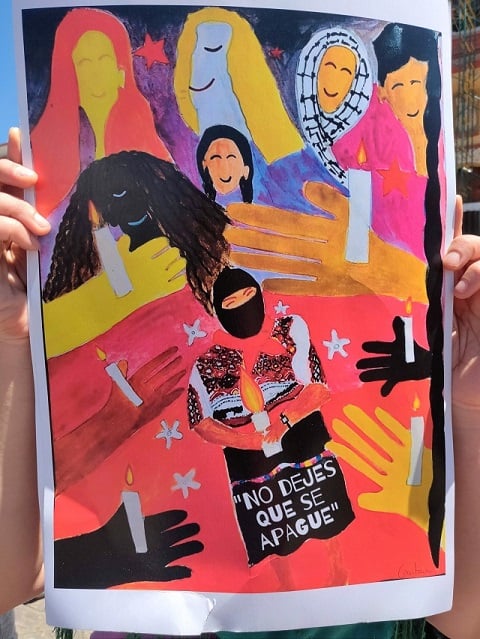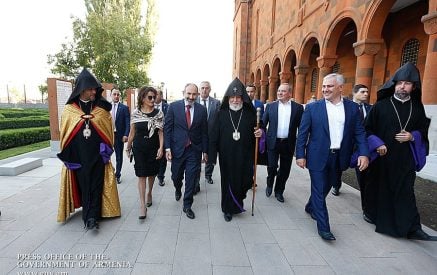“Is the group feminist?” my Musalertsi friend asked in Armenian, her almond-shaped eyes brimming with excitement. Shaking my head as if on autopilot, I replied half truthfully, “No, we’re a human rights organization.” Her face fell, her wide and hopeful grin replaced by a polite smile. Our conversation shifted to the traditional feast she and my cousin-in-law had worked all day to prepare, but for moments of eternity while consumed by shame and fury, I felt unworthy to dine on our grandmothers’ dishes laid out before us.
Why had I said “No” to my friend?
In today’s topsy-turvy world, the visit to Musa Dagh in June of 2019 was lifetimes ago, and yet those moments are etched in my memory, the appearance of internalized misogyny an invitation to turn bitter thoughts into wine and drink my fill.
Read also
For International Women’s Month this March, people around the world are coming together virtually to celebrate and defend the lives of those of us gendered female. On March 5, AGBU Lebanon co-hosted “Women Coping with the Pandemic in a Warzone” to discuss the current struggles and creativity of women in the SWANA region (Southwest Asia and North Africa), including Armenia. Due to COVID-19’s socioeconomic impacts on families, communities and societies nearly everywhere, women and girls—particularly those in areas of conflict who were already marginalized, e.g., due to racism, displacement, queer-and-transphobia—are at even greater risk of violence of all kinds. In the wake of the Artsakh War and ensuing political crises, women-run organizations such as the Women’s Support Center, the Armenian Relief Society and Kooyrigs persist in addressing the immediate and ongoing needs of women and families. There is much work to do.
Throughout the latest cycle of highly asymmetrical violence against Armenians, one of the most troubling internal elements is something I and others feared once the war began: the rise in reports of domestic violence. Without justice and healing, it is as though it is the place of our women and children to keep suffering in silence for the devastating wounds unjustly inflicted upon our people, past and present. As a survivor of child abuse, however different my life in the US is from our people in Armenia and Artsakh, I and those with similar histories know that trap, intimately.
Ages before the Artsakh War and COVID were upon us, the pandemic of violence against women and children became normalized. I do not believe such patterns of behavior are the norm in healthy, supported families and societies. In standing with others to trace the roots of systemic harm and promote life-affirming feminisms, the question remains: why did I not speak the whole truth with my Musalertsi friend?
The group we were discussing, the Faithful Fools, formed in 1998 through an unlikely partnership between two women—a Franciscan sister and a minister clown—in a critically under-resourced San Francisco neighborhood. They began weaving together feminist liberation theology and trickster wisdoms to analyze and creatively respond to “deteriorating social conditions in the US and the world at large, seen from the level of the streets.” In the 2010s, winding roads of healing arts, activism and grappling with Armenian struggles brought me into the Foolish fold. Or was it my fondness for The Fool by Raffi and The Daredevils of Sassoun? Either way, in learning from and with people living and dying on the streets, Fools walk through the city and our inner landscapes to advocate, to accompany and to ask, “What holds me separate? What still connects me? What still separates and connects us?”
As an Armenian woman, what separates me from the word feminist? What still connects me?
A few days prior to the June 2019 feast, I had climbed Musa Dagh with two other women, led by our nimble Musalertsi guide. It was like walking backwards into the future to hike ancestral mountain paths, slowly running my hands along the cool stones of the 1932 monument and drinking in the aromas of wild mountain herbs warmed by the sun. During a midday rest in an enclave overlooking the bluer-than-blue Mediterranean, I made Armenian needlelace and sang lullabies softly. A light breeze dried my quiet tears with the force of generations of Armenian women, historic and current, whose resistance has endured in the face of denied and unrepaired violence against us during the Armenian Genocide and for centuries.
Three months before climbing Musa Dagh, I was in the mountain jungles and city streets of Chiapas, Mexico, for an artist residency, “Aesthetics of Autonomy and Feminisms.” It was centered on the evolving cosmologies of the Zapatista Movement of Indigenous Peoples and the integral role of creative and communal ecofeminists. That International Women’s Day, in response to the femicide epidemic in Latin America we marched through the streets of San Cristóbal de la Casas, chanting and singing together to demand an end to violence towards women. By the end of the day, we were spent but still smiling, determined to keep going.
With safety and good fortune by my side, in between Chiapas and Musa Dagh I was in Armenia, working via the Armenian Volunteer Corps with the women of the Teryan Cultural Center, whose cultural preservation and recovery efforts are currently supporting displaced Artsakhtsis. Back then, thanks to my teachers and friends, learning to make needlelace and Marash embroidery taught me much about the cleverness of our grandmothers. We were delighted to see connections between Teryan’s work and the women-run Zapatista textile collective I had visited in Chiapas, both in their efforts and in the traditional embroidery patterns.
Yet, come June of that year, in my Musalertsi friend’s home, for a moment I was once again the child raised in the US by orphaned and wounded working-class Armenian immigrants, for whom feminist was a dirty word and from whom I learned early on that standing up for myself and others came at a high cost. The Artsakh War and ongoing battles for truth and visibility are teaching me anew that silence is even more costly.
Today, I dream of what could be. Perhaps it’s already here, in the networks of intersectional feminisms flowering in the face of war, hate and transgenerational trauma, bringing faith, hope and a bit of foolish light into the darkest corners of the mind and of the world. Կենա՛ցդ։
Author’s Note: A proper honoring of the Zapatista movement is well beyond the scope of this essay. For more information, visit Schools for Chiapas and Chiapas Support Committee. Suggested in-depth readings: Gloria Muñoz Ramirez, The Fire and the Word: A History of the Zapatista Movement (2008), and Hilary Klein, Compañeras: Zapatista Women’s Stories (2015).
Elise Youssoufian
Main Photo Caption: Zapatista protest poster featuring tiny, mighty Comandanta Ramona and her enduring guidance: “Don’t let your light go out,” Chiapas, March 2019





























































